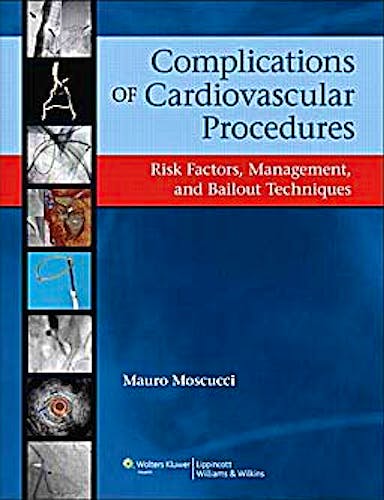

No hay productos en el carrito



Complications of the Cardiovascular Procedures. Risk Factors, Management, and Bailout Techniques
Moscucci, M.
1ª Edición Noviembre 2010
Inglés
Tapa dura
624 pags
1800 gr
null x null x null cm
ISBN 9780781775885
Editorial WOLTERS KLUWER
Summary
Complications in the Cath Lab provides interventional cardiologists, endovascular interventionalists, and physicians in training with a comprehensive resource on the prevention and management of complications in interventional cardiology. The book focuses specifically on risk factors, prevention, and management with conventional and/or with bailout techniques and devices. It includes many images of common and rare complications and of devices.
The first section, on general principles, includes quality assurance, training requirements, legal considerations, adjunctive pharmacotherapy, and conscious sedation. Subsequent sections cover general complications of invasive procedures and complications of specific coronary interventions, noncoronary cardiac interventions, peripheral vascular procedures, pediatric interventions, and electrophysiology procedures.
A companion website includes videos of over 100 complications and bailout techniques.
Features
- Provides information on risk factors and prevention
- Many images and illustrations of common and rare complications
- Guidelines for management of specific complications
- Diverse group of authors with specific expertise in interventional cardiology, structural heart disease, vascular surgery, interventional radiology, neuroradiology, electrophysiology, and pediatric cardiology
Table of contents
Section 1: GENERAL PRINCIPLES
- 1: Risk Assessment
- 2: Quality Assurance and Reporting
- 3: Legal Considerations: Informed Consent and Disclosure Practices
- 4: Training and Facility Development
- 5: When Should a Procedure Not be Done
- 6: Adjunctive Pharmacology (Benefits and Complications)
- 7: Moderate Sedation in Diagnostic and Therapeutic Cardiovascular Procedures
Section 2: SYSTEMIC AND LOCAL COMPLICATIONS OF INVASIVE PROCEDURES IN GENERAL
- 8: Predicting and Avoiding Death, Emergency Surgery, and Other Complications of Percutaneous Coronary Intervention
- 9: Stroke and Neurovascular Rescue
- 10: Periprocedural Myocardial Infarction
- 11: Cardiac Arrhythmias Complicating Interventional Procedures
- 12: Infection
- 13: Complications of Contrast Agents (Including Allergic Reactions)
- 14: Local Arterial/Venous Access Site Complications
Section 3: SPECIFIC COMPLICATIONS OF CORONARY INTERVENTIONS
- 15: Coronary Dissection, Side Branch Occlusion, and Abrupt Closure
- 16: Coronary Perforation, Aneurysm Formation, Covered Stents, and Coil Embolization
- 17: No-Reflow, Distal Embolization, and Embolic Protection
- 18: Retained Devices: Embolization, Guidewire Fracture, and Device Entrapment
Section 4: SPECIFIC COMPLICATIONS OF NONCORONARY CARDIAC INTERVENTIONS
- 19: Transseptal Puncture, Septostomy, LV Puncture
- 20: Valvuloplasty
- 21: Balloon Aortic Valvuloplasty and Transcatheter Aortic Valve Implantation
- 22: Transcatheter Closure of Atrial Septal Defects and Patent Foramen Ovale
- 23: Pericardiocentesis and Pericardiotomy
- 24: Circulatory Support
- 25: Alcohol Septal Ablation
Section 5: SPECIFIC COMPLICATIONS OF PERIPHERAL VASCULAR PROCEDURES
- 26: Carotid Stenting and Intracranial Interventions
- 27: Aortic Endovascular Grafting
- 28: Peripheral Vascular Interventions
- 29: Inferior Vena Cava Filters
Section 6: SPECIFIC COMPLICATIONS OF PEDIATRIC INTERVENTIONS
- 30: Cardiac Catheterization in Children
- 31: Valvuloplasty, Angioplasty, and Stent Placement in Children
- 32: VSD, PDA, Fen Fontan, AV Fistula
Section 7: ELECTROPHYSIOLOGY PROCEDURES
- 33: Implantable Devices
- 34: Catheter Ablation
© 2025 Axón Librería S.L.
2.149.0